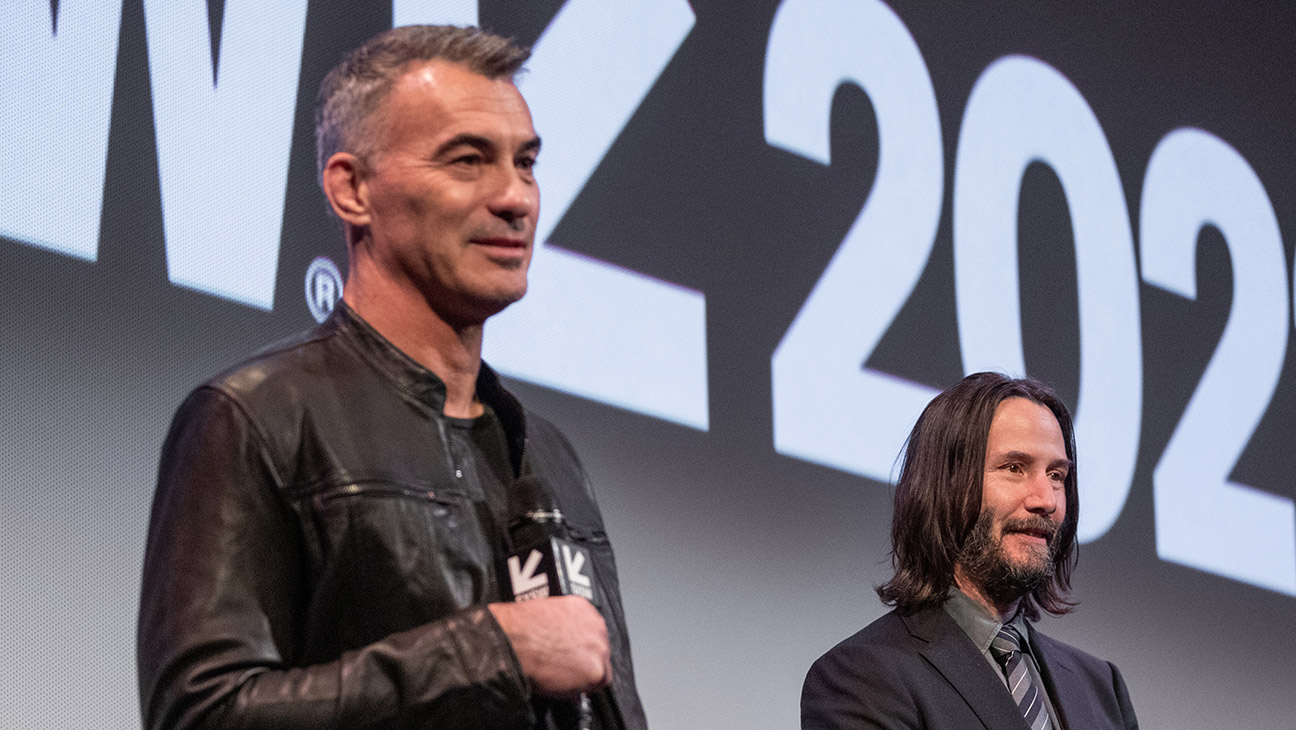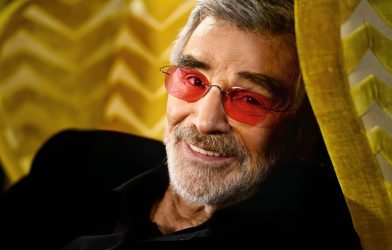Ten years ago, John Wick co-director Chad Stahelski helped give birth to one of cinema’s most prolific assassins and, in turn, one of the industry’s most unlikely franchises.
As Keanu Reeves’ stunt double on The Matrix and the martial arts stunt coordinator for its sequels, Stahelski can attest to the star’s unique relationship with his stunt teams. His gift-giving and overall generosity have been well documented, and when future John Wick co-director David Leitch joined the second and third Matrix chapters as a stuntman, the three of them bonded to the point where Reeves began to track Stahelski and Leitch’s ambitions as business partners and aspiring filmmakers. Years earlier, in 1997, Stahelski and Leitch founded their company, 87eleven, to be a one-stop shop for action design and stunt training, all while climbing the ranks as stunt performers, fight choreographers, stunt coordinators and second-unit directors. (In 2019, Leitch branched off with 87North.)
Their career-altering phone call came in 2013 when Stahelski received word from Reeves about a script he’d been rewriting. And while he initially intended for the duo to lead the action scenes, Stahelski and Leitch were galvanized by screenwriter Derek Kolstad’s screenplay that was then known as Scorn. So they made the case to direct by pitching Reeves their own unique take on the material, and he proceeded to give them the ultimate gift: his blessing.
Wick was originally written to be in his early sixties, but the script still centered around the retired assassin’s vengeful pursuit after his recently deceased wife’s parting gift of a puppy was murdered during a home invasion and car theft. The kill count was around 11 to 15 people, although Stahelski believes he read a draft at one point with only three or four deaths. Regardless, the creative team tweaked Wick’s age since Reeves was 49 at the time of production, and most notably, Stahelski and Leitch ramped up the action, the number of casualties and the mythological component to John’s criminal underworld. Last but not least, the title of Scorn was changed to John Wick, because Reeves always referred to the project as if it was eponymously titled.
After a challenging nine-week shoot at the end of 2013, the directing duo found themselves on the receiving end of some unenthused early screenings.
“God, you should have seen some of the early cuts. At our first friends-and-family screening with the people that actually like us, people were walking out. These were our friends,” Stahelski tells The Hollywood Reporter mid-laugh. “It was pretty rough, and we didn’t really find the movie until very much later.”
In their ongoing effort to refine the film, James Mangold, who’d worked with Stahelski and Leitch on 2013’s The Wolverine, agreed to visit their editing room for a notes session.
“We wanted to make a myth, and other people wanted us to make a movie. But we were like, ‘Fuck it. We don’t want to do a lot with plot,’ and Mangold got that,” Stahelski recalls. “Some of the most complete notes we got were from him, and they led to a lot of structural changes, but it also gave us confidence to go, ‘Yeah, this is weird. Let’s keep going.’”
Eventual distributor screenings were also met with a lot of head-scratching, but in August 2014, Lionsgate was the one distribution company that saw the vision, opting to give the film a wide theatrical release two-and-a-half months later through its Summit Entertainment label. Stahelski and Leitch still felt like they’d missed the mark, as both made plans to return to their existing jobs as either second unit directors or stunt coordinators. But then Austin, Texas’ Fantastic Fest screened the film roughly five weeks out from its Oct. 24 theatrical release, and that’s when the Wick brain trust knew they had a potential crowd-pleaser. The actioner would go on to make over four times its budget with nearly $90 million worldwide, and perhaps most importantly, it struck a chord in the zeitgeist, leading to three more direct sequels, a spinoff movie (more on that below) and a prequel TV series called The Continental.
In 2023’s John Wick: Chapter 4, Stahelski buried Reeves’ latest iconic action character in the ground, at least for the time being, but the franchise has never been more alive than it is right now. The Len Wiseman-directed spinoff, Ballerina, starring Ana de Armas, just dropped a trailer for its June 2025 release. A prequel anime feature is also currently in development, and it will finally show at least some of John’s storied “impossible task” that permitted him to retire for love. Additionally, Robert Levine’s spinoff series, Under the High Table, is being developed for the universe’s supporting characters, while Donnie Yen’s own spinoff movie about his Chapter 4 character, Caine, is actively being written.
Stahelski — who, earlier this year, expanded his role with Lionsgate to oversee the entire franchise — also assisted Wiseman during two weeks of additional photography for Ballerina.
“We went back in with my writing team that had done John Wick: Chapter 4, and my stunt team, and we just gave it a little shine together with Len and what he had already done. It wasn’t that much. Everybody’s like, ‘Ahh!’” Stahelski says before referencing the claims that Ballerina needed “months’ worth” of additional photography. “No, we just went in for a couple of weeks. We changed some of the action sequences and made up for some time that Len just didn’t have. He didn’t have enough time to do some of the bigger shots that it deserved. There was a weather thing in Austria, and so we got to go back in for that. So it’s shaping up pretty nicely.”
As for the development of John Wick: Chapter 5, that subject is a bit more complicated. John Wick: Chapter 4 received the franchise’s highest marks from critics and audiences, as well as the franchise record at the worldwide box office with $440 million. So Stahelski recognizes that there’s still an appetite for the character, but he also believes, in some respects, that Chapter 4 is the conclusion of John’s story. That said, he’s still come up with a few variations that would take the fifth installment in a different direction without being a “cheese-out” to the poignant ending of Chapter 4.
“The honest truth is you don’t [top John Wick: Chapter 4]. You simply don’t. There’s no topping what we did. That’s the end. That’s the deal. That’s what we found closure for. Look, sometimes, we’ll keep things in development. Sometimes, we’ll use development as an exercise, but is there an opportunity to do [John Wick 5]? Of course, there is, whether it’s for money or for creativity,” Stahelski says. “Jesus, in the last three years, I’ve already had three or four versions of a John Wick 5. They were different ways to crack the story, but it’s almost a mental exercise for me.”
Stahelski adds: “It would not be part of that [John Wick: Chapter 4] storyline. It would not be what you would think it is. As far as [John Wick: Chapter 4], we’ve peaked. At least I have. That’s my apex. We ended it. It’s a complete story. I watch it now, and I feel very happy about it, but we wouldn’t try to outdo it. We wouldn’t try to add on to that. It’d have to be a completely different storyline.”
Below, during a recent conversation with THR, Stahelski also discusses his conflicted feelings about John Wick’s ending, as well as how he’d approach the film today.
Well, ten years ago at this time, in the lead-up to release, you and co-director David Leitch certainly weren’t expecting to spawn an original franchise with five movies, a TV series and more on the way. You basically had your bags packed for more second unit work, right?
That is correct. You’re always looking for a job; we didn’t know what would happen. We were in doubt all the way up to Fantastic Fest, [which was nearly five weeks before release]. We were in Austin, Texas. Basil Iwanyk, our producer, got us into Fantastic Fest, and they were glad to have us. So we went down there with Keanu, and everybody applauded. That definitely helped us.
Keanu was a first-ballot hall of famer before John Wick ever came along, but if careers are peaks and valleys, he was probably in a valley at the time. Of course, you had past ties to The Matrix, but do you think his circumstances at the time made him more willing to gamble on a wild premise and two first-time directors?
I don’t know what was going through his head; I’m just glad he was gracious enough to do it. But I’ve known him for quite some time since The Matrix, and while I don’t want to speak for him, I know that he tends to work with people that he’s interested in working with. It’s almost a very personal thing to him. He may love the property, but if he doesn’t love the people he’s going to go in the trenches with, that would be a hard sell for him.
He knew Dave [Leitch] almost as long as me. I had met him almost three years earlier on The Matrix. I did Constantine with him [as the fight choreographer], and then I had kept working with the Wachowskis on some of their stuff. But he kept tabs on us, and when he came to me with [Derek Kolstad’s] script [known as Scorn], he asked me what I could do with it. And maybe because of his career and where it was, it allowed him to work on a smaller budget film, which, in turn, allowed us to get it. If it had been a $150 million version of John Wick with one of the bigger studios, we would’ve even been in the running.
So he was at the point where he was like, “I just want to do a small action movie, but I want to do it my way.” That was his attitude, and to have more creative control and less oversight means slightly less budget, which is what he really needed at the time. He wanted people that saw the same vision and had the same work ethic, so it was probably a combination of both. Where he was at helped create the door for us to go through, but it’s also about the last 20 years all culminating in that magic moment.

Keanu Reeves as John Wick in John Wick
Courtesy of Lionsgate
Did you know that Helen Wick was not the first terminally ill woman to mail a dog to Keanu on screen? Charlize Theron’s terminally ill character in 2001’s Sweet November mailed a dog to Keanu, as well, although his character didn’t know her fate yet. I brought up the coincidence to Charlize once, and it knocked her sideways to the point of texting Keanu.
(Laughs.) Funnily enough, I did not know that at the time. After John Wick came out, I read something about it, and I was like, “Really? How did I not know that?” So maybe we’ll go for three. You never know. (Laughs.)
You’re a better director now than you were then. You’ve always made a point to better yourself between movies.
I hope so.
Would you direct John Wick a lot differently now if you were to re-approach the same script?
That’s a really good question, and I’ve never really thought about that. I don’t think it would be as good, to be honest with you. I don’t think it would be the movie that it is. It’s hard to say, but there always has to be a first, and the first is best. When you’re slightly limited, you have to use a little bit of creativity. You have to use other creative thoughts to get yourself out of holes that are mostly monetary.
If I were to do John Wick with the resources and the trust I have now, I would’ve seen it as a slightly bigger movie. It’d be more along the lines of Bourne or something like that, but I don’t think we would’ve reached the same tone. At the time, I had all these thoughts in my head, but I just wasn’t a good enough director to capture what was all in my head. So you’re searching for the tone throughout.
We shot the first nine days of the film inside John Wick’s house. It was him just moping around and feeding the dog and cleaning out his dead wife’s closet and stuff. We took nine days to shoot that; we shot the Red Circle fight in five days. (Laughs.) As I said, we were trying to find the tone. We were trying to find the character. We didn’t want it to feel like an action movie at first. We wanted it to be this real serious drama and tragic love story. So we were shooting all these little things, and I wouldn’t do that today. I’d probably shoot the whole [grieving John] opening in less than three days, but it wouldn’t have had the same meandering tone or depth into the character. I mean that in a good way. We would’ve skipped things. We probably would’ve been more efficient, but sometimes getting lost helps you find things that you otherwise wouldn’t have had.
So I don’t think there’s a way to recreate the John Wick movies knowing what I know now. Part of what makes them interesting is that discovery was a part of the process. It was us getting good. It was us trying stuff and looking through the anamorphic and the spherical lenses and figuring things out. We were always good shooters from our second-unit work. We were great craftsmen, but we had to find a way to put it all together through tone, pace and rhythm.
God, you should have seen some of the early cuts. At our first friends-and-family screening with the people that actually like us, people were walking out. These were our friends. (Laughs.) They were just shaking their heads, going, “Oh, that’s nice. You guys really tried. Congratulations, but we’re going to go now.” It was pretty rough, and we didn’t really find the movie until very much later.
You thanked James Mangold in the credits. Did he give notes on early cuts?
He did. He watched two cuts. We had worked with him on The Wolverine and some other stuff as second-unit guys, and whenever he called, we were absolutely happy to go work with him on any show that needed stunts and stuff. I had good relationships with Mangold, Guy Ritchie, the Wachowskis, Stallone, Francis Lawrence and Gary Ross. They’re filmmakers that you click with no matter what kind of movie they make. There’s something you trust about them, and you can see the real directorial leadership in them.
After we helped Mangold out on The Wolverine (2013), we were still going back and forth on trying to finish our cut of John Wick. So we asked him, “Hey, we know you’re super busy …” But he didn’t miss a beat. He was like, “Absolutely. When do you want me?” So he came and sat on the couch in our tiny little editorial room in Santa Monica. And he said, “Yeah, this is great. I wouldn’t do this and this, but I’d do this. Try this.” It’s different when you get notes from a studio. Good directorial notes are, “I understand why you did this, but did you try this?” It’s more about trying things; it’s not enough to say, “Oh, that sucked,” or, “That wasn’t good,” or, “It feels bumpy here.” A good director will ask, “Well, have you tried this?” They see the big picture all the way down to the minutia.
So he gave us a lot of stuff, and we tried nearly every note he gave us. Some fit and some didn’t. Tone is, once again, the hardest thing to get in place. We wanted to make a myth, and other people wanted us to make a movie. But we were like, “Fuck it. We don’t want to do a lot with plot,” and Mangold got that. So some of the most complete notes we got were from him, and they led to a lot of structural changes, but it also gave us confidence to go, “Yeah, fuck it. This is weird. Let’s keep going.”

Keanu Reeves as John Wick in John Wick
David Lee
You ran out of money for a big showstopping ending, so is that something that still sticks in your craw?
Every director friend I know looks back at something and says, “I would’ve given anything for this much more.” So, yeah, I still cringe a little bit at some of the stuff we did there, but I’m proud that we got the tone. I’m proud of the gun-fu and the choreography, and what our very limited stunt team and Keanu pulled off with very little prep and very few resources.
We had visions of grandeur. We were in New York, and we wanted to do a car chase though Manhattan, on Fifth Avenue, or through Central Park. On three John Wicks, I’ve tried to do a car chase or a horse chase through Central Park, and I ran out of money all three times and had to come up with something else. That’s why we did the Verrazano Bridge in John Wick: Chapter 3. So I still have a car chase in mind for Wick, and hopefully I’ll get to it in the upcoming installments.
But looking back at the ending that we did at the Naval Yard, we were pretty lucky to pull off what we did. We came up with the car smashing, car-fu, demolition derby stuff. If we had tried to copy other films, it wouldn’t have been what it was. So, sometimes, necessity generates original thought.
One of the most satisfying tropes in action movies is when the bad guys realize who it is they’re messing with, and you guys did it as well as anyone, with Michael Nyqvist’s Viggo saying, “Oh.” Do you remember its origin?
Michael was great. I brought him up because I loved him in The Girl with the Dragon Tattoo, the [2009] Swedish version. When we talked to him, Michael had a pretty good understanding of English, Swedish, and I think he was trying to learn Russian. So there was so much going on in his head. We had written this response with Derek Kolstad where he was like, “Oh, I get it. The Baba Yaga …” So we had that in there, but we had reiterated and repeated ourselves from a scene we’ll do later on in the movie [with Alfie Allen as Viggo’s son, Iosef]. So part of his response was to Aureilo [John Leguizamo] and part of it was to himself in Russian, but it was this cluster fuck of a monologue. We were overlooking New York City at that hotel, and Michael had already done a half-dozen takes, but we didn’t find the rhythm. So I think Michael was a little frustrated with us and just went, “Ugh,” as he walked away. And we were like, “Do that! That’s the one.” And then one or two takes later, he was like, “Oh.” So that’s just the magic of moviemaking. Sometimes one word can take the place of a whole paragraph.
In January 2024, it was announced that you committed to a new oversight role for the entire John Wick universe. I actually assumed you already had this position, so why did it take so long to officially come to pass?
Well, it’s very normal in Hollywood to have all these different inputs as everybody does their own stuff. I’m a slow director, so when I do a movie every three years, there’s lots of time for [talking in between]. And as I was working on John Wick: Chapter 4, there were rumblings that Lionsgate wanted to do another TV show without us, without the creative heart that does the films, such as Keanu and myself. The studio had done The Continental, and they had started to work on their first ancillary movie, Ballerina, which is coming out soon with Ana de Armas. And that was also something that we really didn’t go through.
We then realized very quickly that there were some things in the first couple of drafts that weren’t quite matching either the tone or the mythology of the films. So we all got together, meaning Keanu, myself, Basil Iwanyk, Thunder Road, on how to creatively continue. We’d seen other franchises go through interesting changes, and we were just like, “We need somebody at the gates.” We wanted to do the TV show, the anime and other John Wick projects and spinoffs, but we needed one person to keep it centered. And as the director of all four films, I was the guy that came up with the mythology, and I was in charge of the tone, so that’s where that title came from. I’m the gatekeeper, but everyone is welcome. Nothing has really changed in the creative process; it just filters through me. So I’ll go, “Oh, that’s great, but …”
Keanu and I have been in rooms where other entities would give notes, and somebody would say, “Well, we don’t think that’s very John Wick.” Keanu and I then looked at each other, and I was like, “I don’t know. That’s John Wick right there. Hey, Keanu, do you think it’s John Wick?” And he was like, “Yeah, fuckin’ A, that’s John Wick.” (Laughs.) So as more and more voices come in, it’s more and more important to have at least that one voice as a stop-gate.
Believe me, the John Wicks aren’t easy. They don’t follow a normal good guy-bad guy plot. They don’t follow literally 90 percent of the norms of scriptwriting. You have to be brave and go, “Nope, we’re just telling a story, man. It’s going to be fucked up.” So you’ve got to be a little outside the box, and too many times franchises get funneled into what they think the audience wants or the norm. When you try to serve too many masters, it always goes south, as we’ve seen in many franchises recently.
So we all decided, “Okay, well let’s just have it go through me as a stop-gate.” We have three new things coming up: an anime feature, a TV show, a new spinoff [Donnie Yen’s Caine]. So Keanu and I are still very active on all that, and we didn’t want to get so big that we lost sight of what really makes John Wick, John Wick. So whether it’s the pinball machine or the anime feature film or the new TV show that we’re working on, at least it still comes through us. Every time I get something on my desk, the first person I call is Keanu, and the second person I call is Basil. It’s the same Holy Trinity. And then once we get it all sorted out, we’ll talk to Derek, so it’s still the same people. It’s more of a contractual thing to keep other entities, other folk, that may change from running off on their own and doing that. It’s a way to protect ourselves. To be completely fucking arrogant for a second, we didn’t just work the last ten years to see it all go to shit.
The trailer for Len Wiseman’s Ballerina was just released, and it looks really cool from where I’m sitting. Is it shaping up nicely after everyone got together for some course correction?
Yeah, it’s always that way. Look, I’m torn. It’s so flattering to do something little and actually have people like it. The next thing you know, we’re talking about the ten years of it all, and I still remember when we couldn’t couldn’t get anybody to watch. So it’s very flattering to have the studio — whether it’s for completely monetary or creative or opportunistic reasons — want that thing to continue. It’s a great feeling. On the other hand, you’re that selfish creator that doesn’t want anybody to fuck it up. You don’t want to share. You want to keep it all under wraps. You want to be a control freak, and I’m very much a control freak. (Laughs.) So you’re constantly torn between the two things.
When they said they wanted to do Ballerina, I was still knee-deep in John Wick: Chapter 4 prep, and that was the most important thing in my life at the time. So you try to give everything you can, but you’re not really overseeing it. I wasn’t really part of [Ballerina] other than, “Hey, go with God. This is what made these good. Try to hold onto these axioms, and you’re good.”
Like I said earlier, John Wick is a weird project, man. It shouldn’t have worked on any piece of paper. The algorithm simply does not work. It shouldn’t work. It had that once-in-a-lifetime mix of me and Dave and Keanu at the right time, and Derek had written this really odd script as a first-time screenwriter. The industry was also coming out of a weird time with all the shaky cam. So it was a weird thing that just kind of happened, and to try to recreate that again with a whole other crew and a whole other director and nobody from the original … I’ve been through five studio presidents in my ten years [at Lionsgate], and you’ve got to go through that first conversation every time where you talk them out of all the notes you get. So, what do you think the chances are that they’re going to nail it on the first go? We even talked about it. But they got Ana and they got the vibe right, and while [director] Len [Wiseman] had really no money and time compared to what I had on John Wick: Chapter 4, they got quite far. They got something that was really interesting with massive potential. It was a big swing.
So we went through it, and Keanu and I sorted out what we’ve been talking about today. We went back in with my writing team that had done John Wick: Chapter 4, and my stunt team, and we just gave it a little shine together with Len and what he had already done. It wasn’t that much. Everybody’s like, “Ahh!” But, no, we just went in for a couple of weeks. We changed some of the action sequences and made up for some time that Len just didn’t have. He didn’t have enough time to do some of the bigger shots that it deserved. There was a weather thing in Austria, and so we got to go back in for that.
So, yeah, it’s shaping up pretty nicely. Remember, I’ve been in John Wick 4 mode where we were in seven countries, but Ballerina is just trying to make its debut. So I have visions of grandeur, but we’re just trying to find the middle ground.

Keanu Reeves and Chad Stahelski on the Set of John Wick: Chapter 4
Murray Close/Lionsgate
I was surprised, yet not surprised, about the development of John Wick 5. John Wick: Chapter 4 just felt like it was a perfect ending for John, and the test audiences, as you explained to me, preferred the more definitive version of that ending. John even saved a dog in a full-circle moment. So how do you write a better ending than that?
The honest truth is you don’t. You simply don’t. There’s no topping what we did. That’s the end. That’s the deal. That’s what we found closure for. Look, sometimes, we’ll keep things in development. My creative team and I can’t stop thinking about Wick. Sometimes, we’ll use development as an exercise, but is there an opportunity to do [John Wick 5]? Of course, there is, whether it’s for money or for creativity. Of course, there’s an opportunity, but it keeps us thinking. Jesus, in the last three years, I’ve already had three or four versions of a John Wick 5. They were different ways to crack the story, but it’s almost a mental exercise for me.
In our industry, you’ll always hear of “active development.” They’ll say, “That’s in active development,” and yes, it is — if you count me sitting around bullshitting with Keanu or writing with Mike Finch or my partner Alex. We’re writing things and coming up with great sequences, and that’s a great exercise that we pilfer from and use.
So we have some really good ideas, and it would not be part of that [John Wick: Chapter 4] storyline. It would not be what you would think it is. If we could ever crack it to where Keanu and I thought it was a great idea and it didn’t feel like a cheese-out, then that’s great. But as far as [John Wick: Chapter 4], we’ve peaked. At least I have. That’s my apex. We ended it. It’s a complete story. I watch it now, and I feel very happy about it, but we wouldn’t try to outdo it. We wouldn’t try to add on to that. It’d have to be a completely different storyline.
It sounds like an epilogue-type thing.
Right now, we’re knee-deep in development on a feature anime about John Wick. It’s a prequel to the movies, which is awesome. It’s fun that it’s in a different medium.
Is it John’s impossible task that allowed him to retire for the married life?
Ish. You’re pretty right on, but it’s animated fun. It’s meant to be fun. Some of the prequels and sequels that you see in other franchises, we’re not meant to be built that way. We just want to have fun. We want to have fun with the Wick world, but we’ve already capped it on one end [with John Wick: Chapter 4], so let’s go back and use a different medium.
That’s also what’s fun about the TV show [Under the High Table] that Rob Levine, the showrunner, has designed. It’s in the John Wick universe, and it’s about all the ancillary characters other than John Wick. So you can explore things that we couldn’t do in the features. To keep churning out episodes of John Wick’s adventures seems a little false to us, but to explore different aspects of the world and different aspects of John Wick before the films and through a different medium, whether it’s anime or TV, that feels fun. We can be a little bit more crazy and nutty in the anime, and we can be a lot more explicit in our storytelling and world building on the TV show. So those are exciting to us without seeming repetitive, and that’s where we’re putting our energies right now.
I just spoke to Halle Berry, and she sounds eager to get back in the game as Sofia.
I’d work with Halle any chance I got. She’s always on our mind. There really isn’t anybody from the John Wicks that we don’t love and wouldn’t try to bring back in one of the other mediums that we try to do. She’s awesome.
The Donnie Yen spinoff movie was believed to be next, but it certainly sounds like the anime feature is the leader in the clubhouse.
These are all going on at the same time. The Donnie Yen feature, we’re building it right now. We’re in the middle of writing it right now.
“Active development.”
(Laughs.) See, you’re catching on, brother.
John Wick has been so influential on the industry. Your style of action, or the way it’s shot, has been mimicked time and time again, and instead of Die Hard on a [insert location], so-and-so’s John Wick has become the latest action movie formula. As flattering as it probably is, does part of you wish people would focus on creating the next John Wick rather than another John Wick?
Yeah. I come from a choreography background, and I can count on one hand the people who I would consider to be the top fight/action/martial art choreographers on the planet. There’s very few. There’s a lot of great stunt coordinators, second-unit directors, action directors and martial arts stuntmen, but the real guys that get it know that it’s like fashion. For every person who says, “Let’s copy Fong Sai-yuk. Let’s copy Wong Fei Hung. Let’s copy Jet Li. Let’s copy Jackie Chan. Let’s copy The Raid. Let’s copy John Wick,” there are the real ones that go, “No, fuck that. We’re going to do the next thing. We’re going to try to find it.” And that starts with the cast member. We didn’t have a lot of time on John Wick. Keanu had a bad knee. We couldn’t take the time to cover punches and kicks, so we were like, “Fuck it. We’ll do aikido, jiu-jitsu, sambo and the grappling arts so we can do longer takes. We’ll treat it like Fred Astaire.” We tried to push the same stuff when we were just action directors for years. It wasn’t like we just came up with that choreography. We were pushing it forever, but no one wanted it.
The main disconnect in the industry is that most directors don’t know the world of choreography that well, so they’ll just say, “The studio will hire me a stunt coordinator, and it’ll all be good.” No, it will not. I love my stunt community, but we are not all the same. Some are car specialists, some are creative, some are executors. We’re all different. So if you want to break the mold, you have to do your research and find the teams and the actors that can deliver it. Directors will spend months picking the camera and the lenses and doing screen tests, but you know how many people end up doing a martial arts screen test other than us? (Stahelski laughs following his rhetorical question.) So if you are in the action movie business, you better focus on some action, and my advice would be to dig in. If you want the movie to feel different, then the action is going to be a big part of that, and you should look for what’s next. And if you don’t control the narrative through all the departments, then you’re not going to get that mise-en-scène effect that we did in John Wick. We were in charge of our own destiny at that point.
Do actors often approach you to create a John Wick-type movie for them?
Honestly — and I mean this in the most flattered and humble way — it happens every week.









